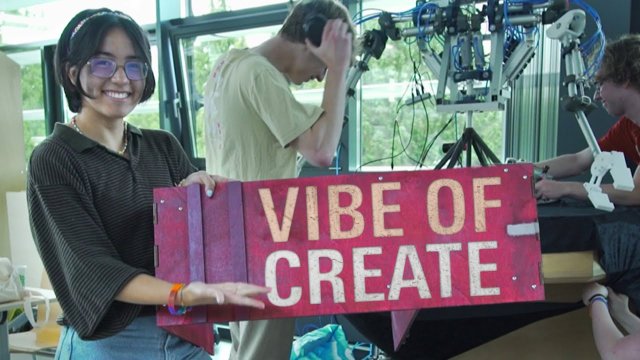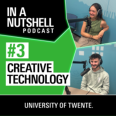Get creative in developing smart, innovative and socially relevant tech solutions.
What happens when you add music to a book? How do you visualise data streams? And how can you reduce discomfort for people with chronic pain through tech solutions? If diverse questions like these intrigue you, our three-year, English-taught Bachelor’s in Creative Technology at the University of Twente (UT) or Vrije Universiteit Amsterdam (VU) is the right choice for you.
The Bachelor’s in Creative Technology (CreaTe) will equip you to use the latest technology for developing solutions that contribute to a better future for people and society. Throughout the many hands-on projects, you will gain technical knowledge and skills, as well as the ability to understand how media and technology influence humans, design and creative processes. Using your extensive knowledge of computer science and electrical engineering, you will learn to cover the entire creation process: from identifying the core question to building a working prototype and testing it on users.

Are you curious about what it is like to study Creative Technology? In this video, students and teachers give insight into what they do, who they are, and especially, what the vibe is like at Creative Technology.
Why study Creative Technology?
- Make a difference in society
As a Creative Technology graduate, you can work on all kinds of projects that are important for our future society. For example, you could be the person who designs and carries out solutions for urban flooding, so that people in areas sensitive to flooding can keep their feet dry when the sea level rises. Or maybe you will be the creative mastermind behind a new robot with emotional awareness, or a 3D printer that can produce an artificial hip. Whether you choose to continue studying after your bachelor’s or want to explore the many career options, your work will matter!
- Pursue your personal interests
Within Creative Technology, there's a lot of room for personal attention and development; we encourage you to engage in extracurricular activities that will stimulate your personal growth. You may even get study credits for such initiatives, if you can show that a certain activity is important to you, contributes to what you want to achieve and is related to your field of study. Think, for example, of attending a conference, assisting a researcher, taking a study trip abroad, or taking a course on video production. Who knows, one of your designs may attract the spotlight at the Dutch Design Week, the Almelo Light Challenge, or the Gogbot festival! Your ideas and input matter - we want to support whatever helps you flourish on a professional and personal level.
- Become a well-rounded, internationally oriented technology expert
As a student Creative Technology, you will become acquainted with many different aspects of technology and the entire creative design process: from mapping out the research question to brainstorming about solutions, and from researching your target group to building the first working prototype and testing it in real life. Putting your knowledge into practice during multidisciplinary projects with other students from all over the world will prepare you to work across cultural and disciplinary borders - much like the work field you will enter after graduation. Our richly varied study programme and project-oriented education will open up many exciting directions and help you become the well-rounded, internationally oriented professional the future needs!
- Attend a programme with a lot of personal attention
Education at the University of Twente is known to be personal and informal, and this Bachelor's is no different. We have an open-door policy and you will receive more individual attention and guidance than at most other universities. The atmosphere between lecturers and students is friendly and informal: you can always approach someone with your questions. Together with our active study association Proto, we continuously improve our education and organise all kinds of study-related activities. Here, you will live your student life to the fullest and grow both professionally and personally!
Download brochure
Related stories
Future jobs
After studying Creative Technology, you will find plenty of interesting opportunities in the job market - especially when you have followed up your bachelor's with a master's degree. To give you an idea, here are some positions you may end up in as a graduate.
- Business Analyst / Consultant
- Innovation Developer
- Product Owner / Developer
- DevOps Engineer
- Scrum Master
- Entrepreneur
- UX Designer
Programme overview
Certification: BSc
7522 NB Enschede
The Netherlands
Related programmes
Below you find a list of educational programmes which are (closely) related to Creative Technology.
Interested in science and technology, but rather not focus on one field? This Bachelor’s combines electrical engineering, mathematics, mechanical engineering, nanotechnology, robotics and more.
Learn how to use mathematics to find solutions to complex societal challenges in, for example, healthcare, logistics, technology or climate change.
Learn to understand the fundamental laws of nature and apply them in innovative technologies and sustainable solutions in this Dutch-taught Bachelor’s.
Learn to design, develop and improve innovative healthcare technologies such as rehabilitation robots, artificial organs, prostheses and imaging technologies in this Dutch-taught Bachelor’s.
Use chemistry to understand, design and develop new sustainable processes, materials and solutions.
Roads, buildings, dikes, bridges: in this Bachelor’s, you learn how to combine technical and non-technical knowledge to design, construct and manage large projects in construction & infrastructure.
In this unique programme, you will study Creative Technology in Amsterdam, while benefiting from the small scale, personal attention and technical expertise for which the UT is renowned.
Electrical engineering lies at the foundation of most technology. In this Bachelor’s, you dive into digital computing, wireless communication, and electronic sensors and systems to design the future.
Combine your creativity with technology to design and improve products, services and systems that make a real difference.
Are you analytical and interested in maths and business processes? In this Bachelor’s, you combine technical know-how, engineering, and management skills to improve business processes.
From rollercoasters to a robotic hand: in this Bachelor’s, available in Enschede and Amsterdam, you learn to invent, design and improve all kinds of appliances, machines, constructions and processes.
In this unique programme, you will study Mechanical Engineering in Amsterdam, while benefiting from the small scale, personal attention and technical expertise for which UT is renowned.
From programming and databases to networks and systems: use your fascination and talent for computers and technology to impact society and businesses.
Develop expertise in both business and IT to help companies perform better and more sustainably in our digital society.
From programming and databases to networks and systems: use your fascination and talent for computers and technology to impact society and businesses.


